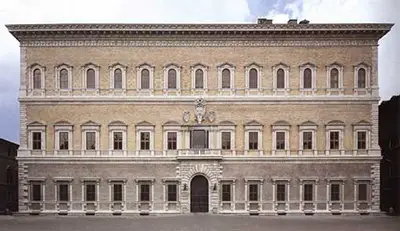The palazzo was started in 1517, redesigned in 1534 and finally modified in 1546 by Antonio da Sangallo the Younger and completed in 1589 under Michelangelo. When Sangallo died, the unfinished work assigned by Cardinal Alessandro Farnese was taken over by Michelangelo who saw the completion of the building.
He got this chance when Alessandro announced a contest following the demise of Sangallo. Michelangelo changed the entire character of the building by adding an extraordinary cornice with Farnese lilies on the uppermost storey. On the centre storey, he made emphasis by including a balcony and a window, bringing everything to a common denominator.
Michelangelo was the first Western artist whose biography was published while still alive and is considered as the greatest sculptor in the west. Although he never viewed himself as a great visual artist, The Last Judgement and the frescos of the Sistine Chapel bring him out as an excellent painter.
In his time, he was also one of the best architects. His artistry work demonstrated a blend of physical realism and psychological insight with deep intensity and uniqueness.
For that reason, his talent was recognised by his contemporaries, and he received commissions from very wealthy and influential men of his time, including popes. Below are some of the famous works of Michelangelo di Lodovico Buonarroti Simoni.
The Sistine Chapel Ceiling
In 1502, Michelangelo was commissioned to sculpt a grand tomb by Pope Julius II. Later before the completion of the sculptor, the pope shifted from the project as he became involved in military disputes.
Funds also became scarce, and as a result of displeasure, Michelangelo left Rome without completing the project. In 1508, the Pope called him back to Rome for an ambitious painting project. The project was to depict 12 apostles on the Sistine Chapel ceiling.
This was a very sacred part of the Vatican where the election and inauguration of new popes were done. Over the course of the seven years, Michelangelo was handling the project, and he worked on 12 figures, including five sibyls and seven prophets. These were placed around the border of the ceiling. The creation of Adam that features God and Adam outstretching their hands towards each other is the most famous Sistine Chapel painting.
David
This is seen as the world’s most famous sculpture that was designed by Michelangelo within a period of three years. Unlike most other depictions where David has been brought out as heroic after the battle, Michelangelo chose to show him in a tense position prior to the fight. The 14 feet sculpture was in 1504 first positioned in Piazza Della Signoria and later moved to Galleria dell’Accademia in 1873.
Bacchus
This was the first large sculpture ever designed by Michelangelo. It was also one of the few works created with paganism in mind. Depicting the Roman god of wine in a drunken stance, it was commissioned by Raffaele Riario who later rejected it. The statue later found a place to stay in the Jacopo Galli’s roman palace.
Madonna of Bruges
This was the only sculpture that made its way out of Italy during Michelangelo’s lifetime. His depiction differs from earlier illustrations of the same subject where a pious virgin is seen to smile down at her son. In this creation, Michelangelo depicts Jesus as standing almost unsupported by his mother, and he appears to be stepping away from her lap. Mary is seen to look away from her son and not paying any attention to him. The sculpture shares certain similarities with the Pieta, especially with the long oval face of Mary reminiscent of the Pieta. Madonna of Bruges was later in 1514 donated to the Church of Our Lady. The sculpture has been on two occasions moved from the church, and the first occasion was during the French revolution wars, only to be later looted by Nazi soldiers during World War II.
His work between 1520 and 1527 in the Medici Chapel in Florence included windows, wall designs, and cornices that appeared unusual in their proportions and design. He also created the St. Peter’s Basilica dome in Rome, dedicating 20 years to it but refused to be paid for the entire project as he had dedicated it to the glory of God. The other masterpieces linked to him are Moses, Day and Night and Dawn and Dusk, all completed by 1533. From then on, he began writing poems, many of them incorporating the philosophy of Neo-Platonism, love and ecstasy. After a short illness in 1564, Michelangelo died at the age of 88, an age that was beyond the life expectancy of his era. He had begun sculpting a Pieta intended for his tomb, but it remained unfinished although still on display at the Museodell’Opera in Florence.


